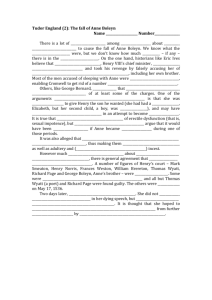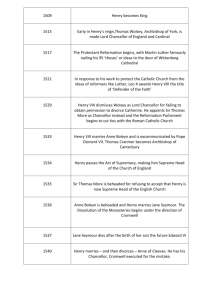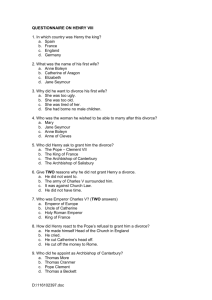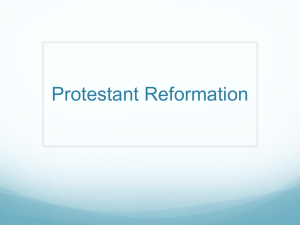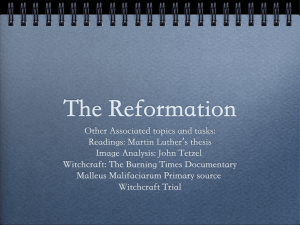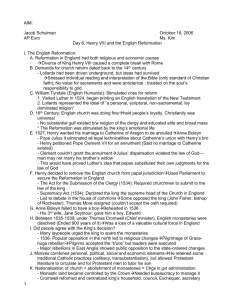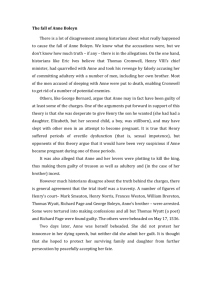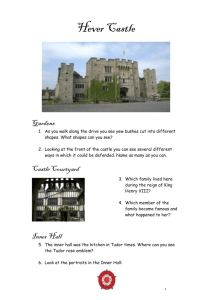Criticisms of the Pre-Reformation church
advertisement
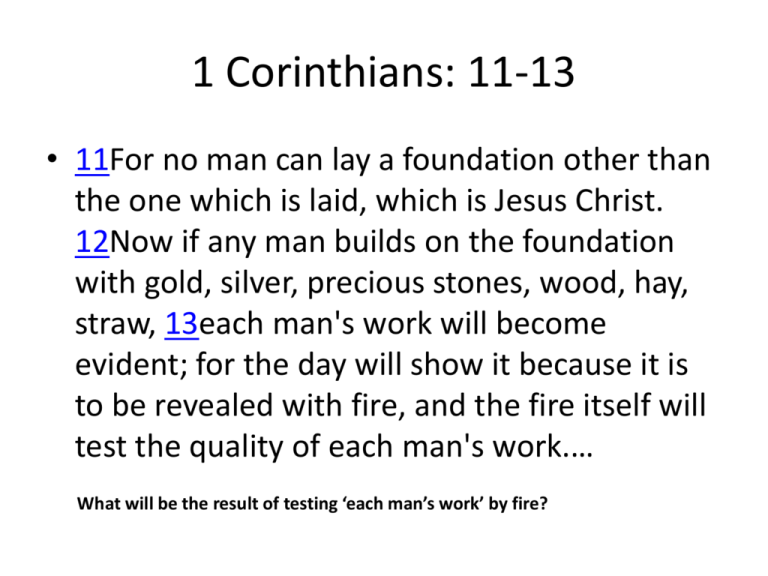
1 Corinthians: 11-13 • 11For no man can lay a foundation other than the one which is laid, which is Jesus Christ. 12Now if any man builds on the foundation with gold, silver, precious stones, wood, hay, straw, 13each man's work will become evident; for the day will show it because it is to be revealed with fire, and the fire itself will test the quality of each man's work.… What will be the result of testing ‘each man’s work’ by fire? What is the message of Hieronymous Bosch’s The Haywain? With the Shutters closed: The Wayfarer Criticisms of the Pre-Reformation church Was the pre-reformation Church ‘an unseaworthy’ vessel (A.G. Dickens)? Popular anti-clericalism • Several of Chaucer’s Canterbury Tales published in the late 14th century reflect a cynicism about churchmen - especially the Pardonner’s Tale, the Summoner’s Tale, and the Friar’s Tale • But the target appears to be corrupt officials rather than church doctrine. • It is not so much the system that is attacked by Chaucer, but the cynicism with which it is exercised by some members of the church. • By the 15th century, these tales were becoming more widely available thanks to the invention of the printing press. ‘Erastian’ anti-clericalism - the Richard Hunne case • A dispute over Mortuary fees led to Richard Hunne’s arrest. • Whilst in prison he accused his captors of praemunire. • During his captivity his house was searched and Lollard writings were found. • Accused of denying transubstantiation • He was found hung in his cell in an ecclesiastical prison. Erastian criticisms • Benefit of clergy • Tithes • Simon Fish, A Supplication for the Beggars, makes criticism of this: • ‘These are not shepherds, but ravenous wolves going about in sheep’s clothing, devouring their flock…’ Humanist anticlericalism • Pluralism • Non-residency • Simony • But also called for a more personal religion, based on accurate translations of the Scriptures. • In 1511 John Colet, humanist scholar and Dean of St Paul’s preached a sermon since made famous by historians – criticising the ambitions of the higher clergy, and its absenteeism, pluralism, simony. • A year before, William Melton, chancellor of York Minster, published his Sermo Exhortatiorius complaining about the ignorance of the clergy. 4 Types of Anti-clericalism • 'Popular’ anti-clericalism - a widespread dissatisfaction with the Church at a local level, not motivated by theological principal but by a cynicism about the motives of its office bearers. That this existed is perhaps illustrated by Chaucer’s Canterbury Tales (late 14th century). • ERASTIANISM anti-clericalism - represented by Thomas Cromwell. This is about laymen wanting to rid the Church of foreign authority and to bring church courts within the state’s judicial framework. This is illustrated by the reaction to the Richard Hunne case of 1512. Christopher St Germain was an important theorist for this strand. • Humanism - criticism leveled at the clergy by humanists like Erasmus and Thomas More (who remained Catholic) and Thomas Cranmer (who didn’t) because they wanted to see improvement. This was a theologically-based programme of reform to bring fundamental change to Christian life in England • ‘Heretical anti-clericalism’ - e.g. Lollardy, a fourteenth century heresy, that shared many of the concerns of Lutheranism - for vernacular scripture, personal piety, opposing many features of traditional religion, including some of the sacraments and the cult of saints. There is evidence of its survival into the 16th century, and must have provided some support for Lutheranism, there is no evidence for this in the north of England. • Lutheranism Like many of his contemporaries, Martin Luther was a humanist, so his ‘reformation’ was very much based on a new and closer reading of the scriptures. • Where he differed from Erasmus, Thomas More and other humanists was that he did not merely see the system as corrupt. He saw it as CORRUPTING. • His initial focus was an attack on indulgences in 1517. He argued bitterly in his 95 theses that salvation was not something that the church could sell. • More fundamentally, salvation could not be EARNED at all. Instead it was a free gift of god. • For example - “Knowing that a man is not justified by the works of the law, but by the faith of Jesus Christ, even we have believed in Jesus Christ, that we might be justified by the faith of Christ, and not by the works of the law: for by the works of the law shall no flesh be justified” (Gal. 2:16) Luther’s central claim was that Salvation was by faith alone (sola fide) Why was this claim so revolutionary? Lutheranism • Besides sola fide, Luther commended two other key ideas: • Sola Scriptura • The priesthood of all believers. • Be aware these are ideas at this stage – it is not clear what protestantism is. • Not every ‘protestant’ agrees with Luther – Melanchthon, Martin Bucer, and later Calvin – have different views on matters such as the Mass, predestination etc. The role of Anne Boleyn Anne Boleyn became an advocate for protestants it would seem. We know that she lent Henry Tyndale’s Obedience of a Christian Man’, a book which used Old Testament and early Christian history to defend the power and authority of kings and to insist that the King’s subjects owed allegiance only to their king. • Simon Fish’s A Supplication for the Beggars was addressed to the king and fiercely criticized greedy and over-fed clerics. • Christopher St Germain emphasised the role of the state in controlling the church - using scriptural support and earlier thinkers like Marsilius of Padua. He also attacked the church for its abuses and alleged racketeering. Anne Boleyn was also in regular contact with a group of Cambridge academics who included Hugh and William Lattimer, Matthew Parker and, most prominently, Thomas Cranmer. How popular was the prereformation church? Some historians would have us believe that this was more or less all there was to reformation in England – that being politically motivated it was IMPOSED from above on an unwilling populace (Eamon Duffy). However, others – like A.G. Dickens – argue that there was in fact a groundswell of opinion within England that the Church was ‘unseaworthy’ and that the momentum for Reformation came from below. The King’s Great Matter was therefore the OCCASION for the Reformation but not its fundamental cause. How popular was the prereformation church? • Study the chart 9D and sources 9.10-9.14 on pages 112113. • Then read the sources 9.10-9.14. • Write a substantial conclusion (or more if you wish) to the question, citing the historians and using what arguments you can. Were the origins of the English Reformation from above or below? • From below (AG Dickens). The English church of the 1520s was ‘an unseaworthy vessel’, undermined by corruption, ignorance and a clergy wedded to unthinking conservatism. Widespread discontent, in the form of Lollardy and anti-clericalism, then of reforming and Lutheran ideas, created a pressure for change. Cromwell personified those beliefs and engineered reform, but did not create the demand for it. (pp124-25) • From above (Christopher Haigh, JJ Scarisbrick, Eamonn Duffy). The English church was widely accepted by the English people. Evidence of this abounds: endowments, lay fraternities and guilds, popular devotion. Instead, the real origin of the reformation is Henry’s divorce; change was imposed upon an unwilling people. (pp125-26) Robert Whiting concludes • The evidence surveyed would suggest that, on the eve of the Henrician Reformation, traditional religion continued to attract a substantial and often impressive degree of popular support. This support, however, was markedly higher for some components (like parish churches) than for others (like monasteries). In general… it seems also to have been higher in the north and west than in the south-east.’ • Who is closer to the truth, A.G. Dickens or Eamon Duffy and why? • Wolsey received a papal commission to dissolve smaller monasteries • So is Henry showing himself to be a good steward by closing down the smaller monasteries. • Suffragan Bishops Act – all but one of the new bishoprics are former abbots. Key events/phases • 1521 - Doubts about succession probably already arising • 1524 - Henry stops sleeping with Catherine • 1526 - Henry begins affair with Anne Boleyn • 1527 - First phase of divorce quest - diplomatic negotiations with Rome, William Knight sent to Rome - evidence that Henry has his doubts about Wolsey’s ability or desire to obtain the divorce. Henry informs Catherine of his intentions. • 1528 - Second phase Wolsey attempts to obtain obtain divorce by getting legatine council held in England • 1529 - Council advoked to Rome - begins the third phase of the quest for the divorce - about which Historians have debated whether Henry was in a state of ‘policy drift’ (Elton; Randell), or preparing the foundations for a break (Bernard). • 1532 - Submission of the Clergy - seen by Thomas More as a turning point, and he resigns as Lord Chancellor the day after on May 16th. • 1532 - August Archbishop Warham dies • 1532 - December - Anne Boleyn accompanies Henry on trip to Calais; falls pregnant • 1533 - January - Henry marries Anne in secret • 1533 - March - Act in Restraint of Appeals - The fourth and final phase begins - the process for dismantling papal power in England begins in earnest. This act provides first statement of imperial kingship in law, and the theoretical foundation for the break with Rome and the Royal supremacy. • Anne Boleyn was the most important person in bringing about the King’s divorce in the years 1529 to 1533’. Explain why you agree or disagree with this view.
